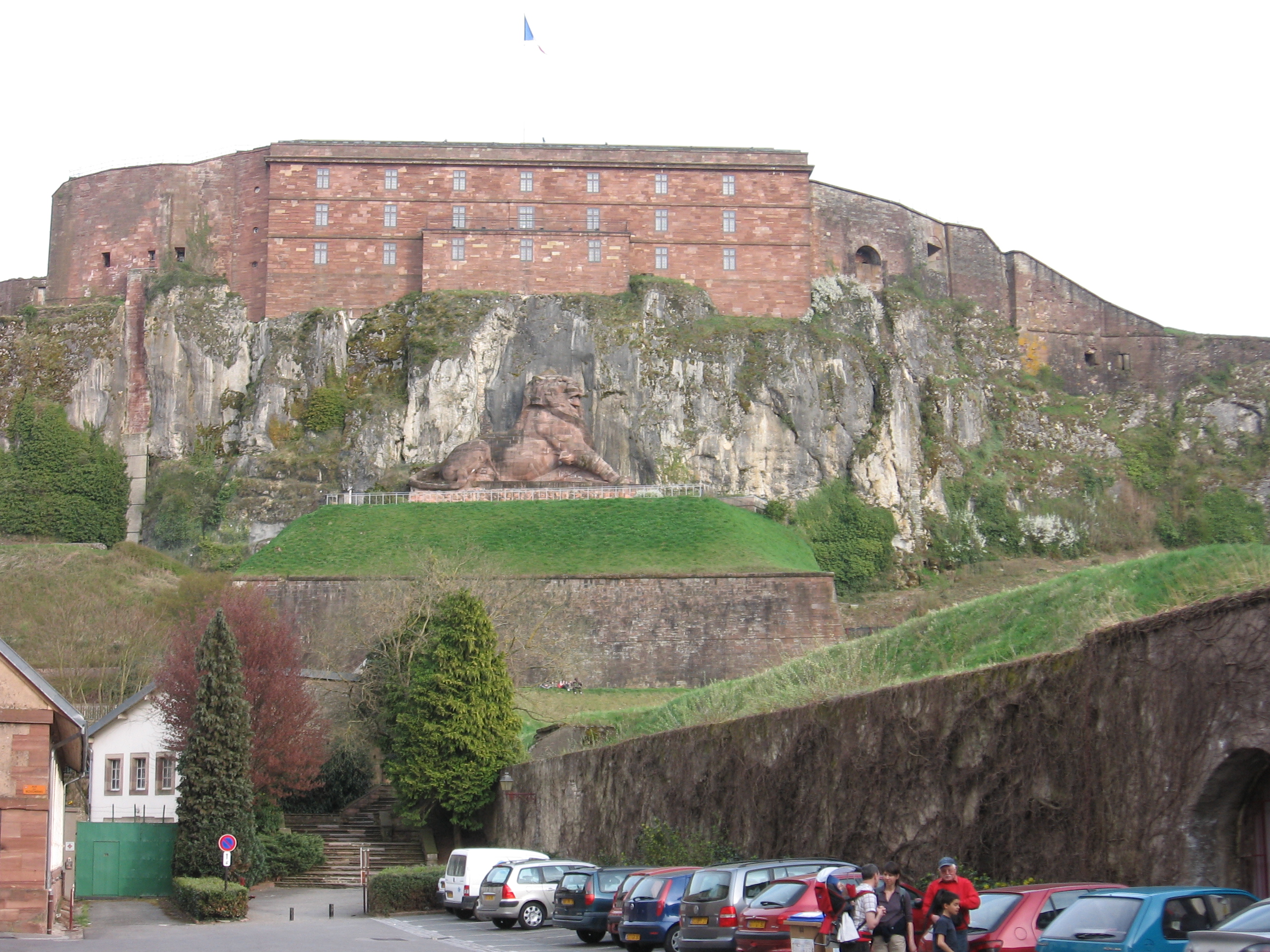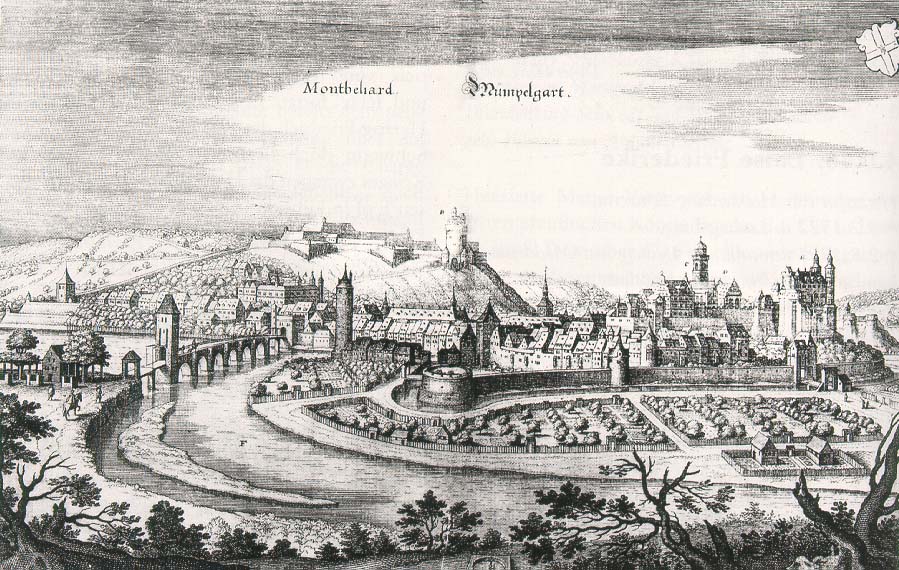|
Fort Du Bois D'Oye
Fort Bois d'Oye, also known as Fort Eblé, is located in the commune of Bermont. It was built between 1883 and 1886. It is part of the second ring of fortifications around the city of Belfort in northeastern France. This second ring of forts was built as part of the Séré de Rivières system and incorporated improvements to deal with the improvement in efficacy of artillery in the late 19th century. Description The large pentagonal fort was built of limestone, with walls surrounding a large open court. At an elevation of 420 meters, the fort was designed to overlook the railways Montbéliard and Delle, and to cover its neighbors, Fort Lachaux and Fort de Vézelois. Water was provided by a well and cistern. The garrison included 624 soldiers, 32 non-commissioned officers and 17 officers. Initial armament included 17 155mm long guns, 5 120mm long guns, 2 220mm mortars and several smaller weapons. In 1890 a large personnel shelter (''abri-caverne'') was built north of the fort. In ... [...More Info...] [...Related Items...] OR: [Wikipedia] [Google] [Baidu] |
Fortified Region Of Belfort
The fortified region of Belfort () formed the first line of defense in the Séré de Rivières system of fortifications in the Belfort Gap. Located in northeastern France between Épinal and Besançon, the primary line was built in the late 19th century to deal with advances in artillery that had made older defensive systems obsolete. History Belfort has been a fortified place since the Middle Ages, when a castle was built in 1226. After withstanding seven sieges, the medieval fortifications were modernized between 1637 and 1648 by the Comte de la Suze. Vauban added hornworks and a barracks to the castle and enclosed the city in a new wall according to Vauban's "second system", which resisted a siege in 1815. As armies made greater use of artillery, it became necessary to extend city defenses to keep opponents sufficiently distant to prevent bombardment of the city from neighboring high ground. The first ring of forts was built at the direction of General Baron Haxo, beginn ... [...More Info...] [...Related Items...] OR: [Wikipedia] [Google] [Baidu] |
Belfort
Belfort (; archaic german: Beffert/Beffort) is a city in the Bourgogne-Franche-Comté region in Northeastern France, situated between Lyon and Strasbourg, approximately from the France–Switzerland border. It is the prefecture of the Territoire de Belfort department. Belfort is from Paris, from Strasbourg, from Lyon and from Zürich. The residents of the city are called "Belfortains". The city is located on the river Savoureuse, on a strategically important natural route between the Rhine and the Rhône – the Belfort Gap (''Trouée de Belfort'') or Burgundian Gate (''Porte de Bourgogne''). It is located approximately south from the base of the Ballon d'Alsace mountain range, source of the Savoureuse. The city of Belfort has 46,443 inhabitants (2019).Télécha ... [...More Info...] [...Related Items...] OR: [Wikipedia] [Google] [Baidu] |
France
France (), officially the French Republic ( ), is a country primarily located in Western Europe. It also comprises of Overseas France, overseas regions and territories in the Americas and the Atlantic Ocean, Atlantic, Pacific Ocean, Pacific and Indian Oceans. Its Metropolitan France, metropolitan area extends from the Rhine to the Atlantic Ocean and from the Mediterranean Sea to the English Channel and the North Sea; overseas territories include French Guiana in South America, Saint Pierre and Miquelon in the North Atlantic, the French West Indies, and many islands in Oceania and the Indian Ocean. Due to its several coastal territories, France has the largest exclusive economic zone in the world. France borders Belgium, Luxembourg, Germany, Switzerland, Monaco, Italy, Andorra, and Spain in continental Europe, as well as the Kingdom of the Netherlands, Netherlands, Suriname, and Brazil in the Americas via its overseas territories in French Guiana and Saint Martin (island), ... [...More Info...] [...Related Items...] OR: [Wikipedia] [Google] [Baidu] |
Battle Of France
The Battle of France (french: bataille de France) (10 May – 25 June 1940), also known as the Western Campaign ('), the French Campaign (german: Frankreichfeldzug, ) and the Fall of France, was the Nazi Germany, German invasion of French Third Republic, France during the Second World War. On 3 September 1939, France French declaration of war on Germany (1939), declared war on Germany following the German invasion of Poland. In early September 1939, France began the limited Saar Offensive and by mid-October had withdrawn to their start lines. German armies German invasion of Belgium (1940), invaded Belgium, German invasion of Luxembourg, Luxembourg and German invasion of the Netherlands, the Netherlands on 10 May 1940. Fascist Italy (1922-1943), Italy entered the war on 10 June 1940 and attempted an Italian invasion of France, invasion of France. France and the Low Countries were conquered, ending land operations on the Western Front (World War II), Western Front until the Normandy l ... [...More Info...] [...Related Items...] OR: [Wikipedia] [Google] [Baidu] |
Bermont
Bermont () is a commune in the Territoire de Belfort department in Bourgogne-Franche-Comté in northeastern France. See also * Fort du Bois d'Oye *Communes of the Territoire de Belfort department The following is a list of the 101 communes of the Territoire de Belfort department of France. The communes cooperate in the following intercommunalities (as of 2020):Communes of the Territoire de Belfort {{Belfort-geo-stub ... [...More Info...] [...Related Items...] OR: [Wikipedia] [Google] [Baidu] |
Séré De Rivières System
The system was named after Raymond Adolphe Séré de Rivières, its originator. The system was an ensemble of fortifications built from 1874 along the frontiers and coasts of France. The fortresses were obsolescent by 1914 but were used during the First World War. Background Following the Franco-Prussian War of 1870–1871, France found itself seriously weakened and isolated from the rest of Europe, menaced by Germany and stung by the loss of Alsace-Lorraine. At the same time as the departure of the last German troops, France created the Defence Committee (), which was active between 1872 and 1888, whose mission was to reorganize the defence of the French frontiers and coasts. It was necessary to compensate for the lost territories of the north-east; to modernise old fortifications, which had been shown to be wanting in the last war and to create new fortifications proof against modern weaponry using new and more powerful explosives. The committee was created by a preside ... [...More Info...] [...Related Items...] OR: [Wikipedia] [Google] [Baidu] |
Montbéliard
Montbéliard (; traditional ) is a town in the Doubs Departments of France, department in the Bourgogne-Franche-Comté Regions of France, region in eastern France, about from the border with Switzerland. It is one of the two Subprefectures in France, subprefectures of the department. History Montbéliard is mentioned as early as 983 as . The County of Montbéliard or Mömpelgard was a feudal Graf, county of the Holy Roman Empire from 1033 to 1796. In 1283, it was granted rights under charter by Count Reginald of Burgundy, Reginald. Its charter guaranteed the county perpetual liberties and franchises which lasted until the French Revolution in 1789. Montbéliard's original municipal institutions included the Magistracy of the Nine Bourgeois, the Corp of the Eighteen and the Notables, a Mayor, and Procurator, and appointed "Chazes", all who participated in the administration of the county as provided by the charter. Also under the 1283 charter, the Count and the people of Montb ... [...More Info...] [...Related Items...] OR: [Wikipedia] [Google] [Baidu] |
Delle
Delle () is a commune in the Territoire de Belfort department in Bourgogne-Franche-Comté in northeastern France. Delle is the last French town on the railway line from Belfort to Berne, in Switzerland. The railway station in Delle is served by trains to Belfort and Biel/Bienne. Population See also *Communes of the Territoire de Belfort department The following is a list of the 101 communes of the Territoire de Belfort department of France. The communes cooperate in the following intercommunalities (as of 2020):Official website * [...More Info...] [...Related Items...] OR: [Wikipedia] [Google] [Baidu] |
Fort Lachaux
A fortification is a military construction or building designed for the defense of territories in warfare, and is also used to establish rule in a region during peacetime. The term is derived from Latin ''fortis'' ("strong") and ''facere'' ("to make"). From very early history to modern times, defensive walls have often been necessary for cities to survive in an ever-changing world of invasion and conquest. Some settlements in the Indus Valley civilization were the first small cities to be fortified. In ancient Greece, large stone walls had been built in Mycenaean Greece, such as the ancient site of Mycenae (famous for the huge stone blocks of its 'cyclopean' walls). A Greek '' phrourion'' was a fortified collection of buildings used as a military garrison, and is the equivalent of the Roman castellum or English fortress. These constructions mainly served the purpose of a watch tower, to guard certain roads, passes, and borders. Though smaller than a real fortress, they acted ... [...More Info...] [...Related Items...] OR: [Wikipedia] [Google] [Baidu] |
Fort De Vézelois
Fort de Vézelois, also known as Fort Ordener, was built between 1883 and 1886 near Vézelois, to the southeast of Belfort in northeastern France. It is part of the first ring of fortifications around the city of Belfort. It is part of the second ring of fortifications around the city of Belfort in northeastern France. This set of forts was built as part of the Séré de Rivières system and incorporated improvements to deal with the improvement in efficacy of artillery in the late 19th century. The fort was formally named after French General Michel Ordener. The Fort de Vézelois is similar to the Fort de Bessoncourt and was designed to support Bessoncourt and the Fort du Bois d'Oye, covering the road from Basel and the Mulhouse railway line. It was garrisoned by between 500 and 600 men. The fort received concrete cover in 1888–89, its artillery dispersed to batteries outside the fort. In 1909 the caponiers were replaced by counterscarps. Parapets and a subterranean shelter ... [...More Info...] [...Related Items...] OR: [Wikipedia] [Google] [Baidu] |
Fortifications Of Belfort
A fortification is a military construction or building designed for the defense of territories in warfare, and is also used to establish rule in a region during peacetime. The term is derived from Latin ''fortis'' ("strong") and ''facere'' ("to make"). From very early history to modern times, defensive walls have often been necessary for cities to survive in an ever-changing world of invasion and conquest. Some settlements in the Indus Valley civilization were the first small cities to be fortified. In ancient Greece, large stone walls had been built in Mycenaean Greece, such as the ancient site of Mycenae (famous for the huge stone blocks of its 'cyclopean' walls). A Greek '' phrourion'' was a fortified collection of buildings used as a military garrison, and is the equivalent of the Roman castellum or English fortress. These constructions mainly served the purpose of a watch tower, to guard certain roads, passes, and borders. Though smaller than a real fortress, they acted ... [...More Info...] [...Related Items...] OR: [Wikipedia] [Google] [Baidu] |
_(6).jpg)





